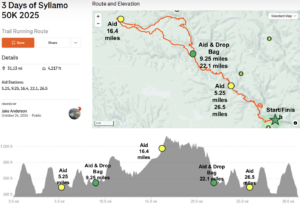Week 1 – The Taper
Asa H -
Over the past five months, I’ve been training to run Three Days of Syllamo. The race is 93 miles in total, run over three days. The first day is 50 kilometers (31 miles), the second day is 50 miles, and the third day is 20 kilometers (12.4 miles). The furthest I’ve ever run is a marathon, 26.2 miles. So, this race will be a big step up. Given the length of the race, I started training back in October. Five months later, I’ve built a sturdy base, and I am beginning to taper.
My training plan was based around slowly increasing my weekly mileage. This weekly mileage came from three longer runs, with shorter runs mixed in. These three runs were meant to mimic the format of the race, allowing me to train for a long run, while already being fatigued. Speaking to people who have already run Three Days of Syllamo, a common thread was that the second day was the hardest, not only because it was the longest, but also because runners are tired from the previous day.
My weekly mileage started off at 32 miles and incrementally built to 60, as of last week. Most weeks, my volume increased by no more than 2 miles. This slow progress was implemented to mitigate the risk of injury, as big week-to-week changes in training volume expose athletes to injury, which significantly slows down training. It’s better to take it slow to begin with, than be forced to by an injury.
Next week, I’ll be running Three Days of Syllamo. The race director recently sent out the elevation map for the course, which I’ll attach below. All three races start and end at the same location, which means the elevation gained is equal to the elevation descended for any given day. The first day has an elevation gain/loss of 4,217 ft. The first day has a lot of ups and downs, with a particularly long climb between miles 13 and 17. The second day follows suit with an elevation gain/loss of 5,695 ft. While the second day involves a lot more climbing, this elevation change is spread out over 50 miles, as opposed to the first day’s 31. Climbs and descents on the second day are generally less steep, the exception being two dips around mile 25. The third day is even less steep, with an elevation gain/loss of only 1,585 ft. There’s a big climb toward the beginning and a big descent towards the end, but the rest of the course hovers around the same altitude.
This week I’ve been tapering down, so that I’ll be ready to perform on race day. Tapering involves significantly reducing my weekly mileage in order to flush out fatigue accumulated over the course of the training cycle. This will allow me to be my strongest and most recovered come next week. This week’s runs were 5 miles on Tuesday, 6 on Wednesday, 8 on Thursday, and 12 on Sunday. My watch hasn’t been working properly this week, so I don’t have the data for all my runs, but I’ll attach the ones I do have below. The runs have felt great this week and I’m feeling ready to crush Syllamo.
In addition to training for the physical strain of the race, over the past few weeks I’ve been practicing what fueling will look like during the race. Eating for running looks very different from eating while running. The recommendations for runners looking to fuel themselves to perform most optimally looks similar to that given to most other athletes. Runners should eat enough carbohydrates, fats, and proteins. Getting enough protein is especially important for athletes as it allows for muscle recovery and growth. Proper fueling in preparation for a race looks like what most people would describe as a “healthy diet.” However, what runners should be consuming during a race is a completely different story. Due to the calories burned from the constant running, it’s important to be continuously refueling the body. Most Ultrarunners recommend consuming between 200 and 300 calories per hour based on what works for your body. Ideally these calories would come from the same kind of whole foods that fueled your body in preparation for the race, but in practice what works is whatever your stomach is able to hold down. Many miles into a race, your stomach can have a difficult time holding down food. Many runners turn to simple sugars and carbohydrate-rich foods. Gels are an easy way to get the sugars, carbohydrates, and calories in a tiny package. That being said, gels aren’t the tastiest.
Apart from training for Syllamo, I’ve been looking at a race to run later in the project. Being able to perform as well or better at another race as I do at Syllamo will demonstrate how well I’m able to recover. One race I’m looking at right now is the Wildflower 50k on May 10th. It looks like a fun course and wouldn’t involve having to train up any further, just recover from Syllamo. I’m still not set and will keep my eyes out for other races.




Comments:
All viewpoints are welcome but profane, threatening, disrespectful, or harassing comments will not be tolerated and are subject to moderation up to, and including, full deletion.